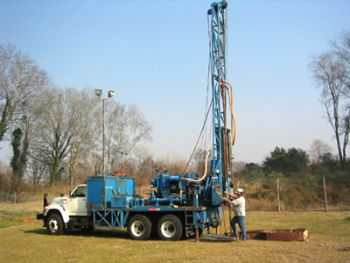Rotary Drilling: Difference between revisions
Rmanwaring (talk | contribs) No edit summary |
Rmanwaring (talk | contribs) No edit summary |
||
| Line 18: | Line 18: | ||
*core drilling."<ref name="NEH_CH5">[[National Engineering Handbook: Chapter 5 - Engineering Geology Logging, Sampling, and Testing | National Engineering Handbook: Chapter 5 - Engineering Geology Logging, Sampling, and Testing, NRCS, 2012]]</ref> | *core drilling."<ref name="NEH_CH5">[[National Engineering Handbook: Chapter 5 - Engineering Geology Logging, Sampling, and Testing | National Engineering Handbook: Chapter 5 - Engineering Geology Logging, Sampling, and Testing, NRCS, 2012]]</ref> | ||
A rotary [[drill]] advances a test hole by rapid mechanical [[rotation]] of the drilling bit (e.g., blade, tricone, and [[coring]] bits), which is made of carbide, tungsten, case-hardened steel, and diamonds. The bit cuts, chips, and grinds the material at the bottom of the hole into small particles. The cuttings are normally removed by pumping water or drilling fluid from a sump down through the drill rods and bit and up through the annular spacing into a settling pit and back to the sump. Compressed air is also available on many rigs as an alternative to remove the cuttings from the hole. Air rotary drilling is essential for drilling in karst areas where circulation loss is expected. | "A rotary [[drill]] advances a test hole by rapid mechanical [[rotation]] of the drilling bit (e.g., blade, tricone, and [[coring]] bits), which is made of carbide, tungsten, case-hardened steel, and diamonds. The bit cuts, chips, and grinds the material at the bottom of the hole into small particles. The cuttings are normally removed by pumping water or drilling fluid from a sump down through the drill rods and bit and up through the annular spacing into a settling pit and back to the sump. Compressed air is also available on many rigs as an alternative to remove the cuttings from the hole. Air rotary drilling is essential for drilling in karst areas where circulation loss is expected."<ref name="NEH_CH5" /> | ||
Rotary-drilling methods can advance test holes in a wide variety of materials, including hard rock. Rotary drilling may be the only practical method of advancing holes and obtaining undisturbed core samples from certain types of soil and rock materials. | "Rotary-drilling methods can advance test holes in a wide variety of materials, including hard rock. Rotary drilling may be the only practical method of advancing holes and obtaining undisturbed core samples from certain types of soil and rock materials."<ref name="NEH_CH5" /> | ||
==[[Best Practices Resources]]== | ==[[Best Practices Resources]]== | ||
Revision as of 16:01, 25 October 2022

|
| Drill Rig |
"Types of rotary drilling include:
- direct rotary drilling;
- reverse circulation rotary drilling;
- dual-wall reverse circulation drilling;
- core drilling."[1]
"A rotary drill advances a test hole by rapid mechanical rotation of the drilling bit (e.g., blade, tricone, and coring bits), which is made of carbide, tungsten, case-hardened steel, and diamonds. The bit cuts, chips, and grinds the material at the bottom of the hole into small particles. The cuttings are normally removed by pumping water or drilling fluid from a sump down through the drill rods and bit and up through the annular spacing into a settling pit and back to the sump. Compressed air is also available on many rigs as an alternative to remove the cuttings from the hole. Air rotary drilling is essential for drilling in karst areas where circulation loss is expected."[1]
"Rotary-drilling methods can advance test holes in a wide variety of materials, including hard rock. Rotary drilling may be the only practical method of advancing holes and obtaining undisturbed core samples from certain types of soil and rock materials."[1]
Best Practices Resources
![]() National Engineering Handbook: Chapter 5 - Engineering Geology Logging, Sampling, and Testing
National Engineering Handbook: Chapter 5 - Engineering Geology Logging, Sampling, and Testing
Citations:
Revision ID: 4044
Revision Date: 10/25/2022
